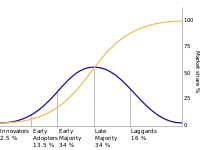
Photo from wikipedia
Using a database of early farming sites in Scandinavia, we estimate that the spread rate of the Neolithic was in the range 0.44–0.66 km yr−1. This is substantially slower (by… Click to show full abstract
Using a database of early farming sites in Scandinavia, we estimate that the spread rate of the Neolithic was in the range 0.44–0.66 km yr−1. This is substantially slower (by about 50%) than the rate in continental Europe. We interpret this result in the framework of a new mathematical model that includes horizontal cultural transmission (acculturation), vertical cultural transmission (interbreeding) and demic diffusion (reproduction and dispersal of farmers). To parametrize the model, we estimate reproduction rates of early farmers using archaeological data (sum-calibrated probabilities for the dates of early Neolithic Scandinavian sites) and use them in a wave-of-advance model for the first time. Comparing the model with the archaeological data, we find that the percentage of the spread rate due to cultural diffusion is below 50% (except for very extreme parameter values, and even for them it is below 54%). This strongly suggests that the spread of the Neolithic in Scandinavia was driven mainly by demic diffusion. This conclusion, obtained from archaeological data, agrees qualitatively with the implications of ancient genetic data, but the latter are yet too few in Scandinavia to produce any quantitative percentage for the spread rate due to cultural diffusion. We also find that, on average, fewer than eight hunter–gatherers were incorporated in the Neolithic communities by each group of 10 pioneering farmers, via horizontal and/or vertical cultural transmission.
Journal Title: Journal of the Royal Society Interface
Year Published: 2018
Link to full text (if available)
Share on Social Media: Sign Up to like & get
recommendations!